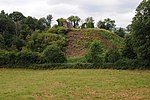Whitney-on-Wye toll bridge
Bridges completed in 1797Bridges in HerefordshireGrade II listed buildings in HerefordshireToll bridges in EnglandUse British English from February 2017

Whitney-on-Wye toll bridge is a single-carriageway, wood- and stone-construction in Herefordshire, England. The toll bridge carries the B4350 south from its junction with the A438, near Whitney-on-Wye, across the River Wye. It comprises two Grade II listed structures.
Excerpt from the Wikipedia article Whitney-on-Wye toll bridge (License: CC BY-SA 3.0, Authors, Images).Whitney-on-Wye toll bridge
Whitney-on-Wye Toll Bridge,
Geographical coordinates (GPS) Address Website External links Nearby Places Show on map
Geographical coordinates (GPS)
| Latitude | Longitude |
|---|---|
| N 52.1201 ° | E -3.0839 ° |
Address
Whitney-on-Wye Toll Bridge
Whitney-on-Wye Toll Bridge
HR3 6EW
England, United Kingdom
Open on Google Maps



